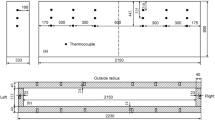Abstract
For modeling solidification process of casting accurately, the correct information about the heat flux boundary condition is required. In this study, an inverse heat conduction model is established to determine the interfacial heat flux at metal-mold in the process of casting with a cylindrical geometry. The numerically calculated temperature is compared with the exact solution and simulation solution obtained by commercial software ProCAST to investigate the accuracy of forward heat conduction model. The analysis of calculated heat flux indicates that the inverse model may be taken as a feasible and effective tool for the estimation of the metal-mold interfacial heat flux during solidification of cylindrical casting.




Similar content being viewed by others
References
Nowak I, Smolka J, Nowak AJ (2010) An effective 3-D inverse procedure to retrieve cooling conditions in an aluminum alloy continuous casting problem. Appl Therm Eng 30:1140–1151
Zhang LQ, Li LX, Ju H, Zhu BW (2010) Inverse identification of interfacial heat transfer coefficient between the casting and metal mold using neural network. Energy Convers Manag 51:1898–1904
Sun HC, Chao LS (2007) Analysis of interfacial heat transfer coefficient of green sand mold casting for aluminum and tin-lead alloys by using a lump capacitance method. J Heat Transf 129:595–600
Guo ZP, Xiong SM, Cho SH, Choi JK (2007) Study on heat transfer behavior at metal/die interface in aluminum alloy die casting process. Acta Metall Sin 11:1149–1154
Rajaraman R, Velraj R (2008) Comparison of interfacial heat transfer coefficient estimated by two different techniques during solidification of cylindrical aluminum alloy casting. Heat Mass Transfer 44:1025–1034
Nallathambi AK, Specht E (2009) Estimation of heat flux in array of jets quenching using experimental and inverse finite element method. J Mater Process Technol 209:325–332
Arunkumar S, Rao KVS, Kumar TSP (2008) Spatial variation of heat flux at the metal mold interface due to mold filling effects in gravity die-casting. Int J Heat Mass Transf 51:676–685
Sui DS, Cui ZS (2009) Application of orthogonal experimental design and Tikhonov regularization method for the identification of parameters in the casting solidification process. Acta Metall Sin 22:13–21
Gadala MS, Xu FC (2006) An FE-based sequential inverse algorithm for heat flux calculation during impingement water cooling. Int J Numer Methods Heat Fluid Flow 16:356–385
Chen WL, Yang YC, Lee HL (2007) Inverse problem in determining convection heat transfer coefficient of an annular fin. Energy Convers Manag 48:1081–1088
Silva JN, Moutinho DJ, Moreira AL, Ferreira IL et al (2011) Determination of heat transfer coefficients at metal-mold interface during horizontal unsteady-state directional solidification of Sn-Pb alloys. Mater Chem Phys 130:179–185
Gafur MA, Nasrul Haque M, Narayan Prabhu K (2003) Effect of chill thickness and superheat on casting-chill interfacial heat transfer during solidification of commercially pure aluminum. J Mater Process Technol 133:257–265
Long A, Thornhill D, Armstrong C et al (2011) Determination of the heat transfer coefficient at the metal-die interface for high pressure die cast AlSi9Cu3Fe. Appl Therm Eng 31:3996–4006
Dong YW, Bu K, Dou YQ et al (2011) Determination of interfacial heat-transfer coefficient during investment-casting process of single-crystal blades. J Mater Process Technol 211:2123–2131
Spinelli JE, Cheung N, Goulart PR et al (2012) Design of mechanical properties of Al-alloys chill castings based on the metal/mold interfacial heat transfer coefficient. Int J Therm Sci 51:145–154
Acknowledgments
The research supports from Open Research Fund Program of the State Key Laboratory of Advanced Design and Manufacturing for Vehicle Body (No.31115009), the Initial Scientific Research foundation of Central South University of Forestry & Technology for the introduction of talents (No.104-0206) and the Youth Scientific Research Foundation of Central South University of Forestry & Technology are gratefully acknowledged.
Author information
Authors and Affiliations
Corresponding author
Rights and permissions
About this article
Cite this article
Zhang, L.Q., Wang, R.J. Estimation of heat flux at metal-mold interface during solidification of cylindrical casting. Int J Mater Form 6, 453–458 (2013). https://doi.org/10.1007/s12289-012-1098-3
Received:
Accepted:
Published:
Issue Date:
DOI: https://doi.org/10.1007/s12289-012-1098-3




